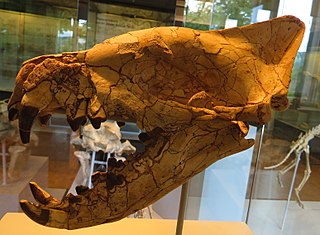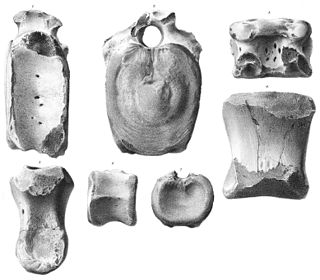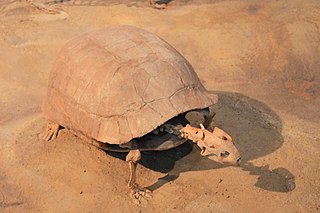
Trachodon is a dubious genus of hadrosaurid dinosaur based on teeth from the Campanian-age Upper Cretaceous Judith River Formation of Montana, U.S. It is a historically important genus with a convoluted taxonomy that has been all but abandoned by modern dinosaur paleontologists.

Hadrosaurus is a genus of hadrosaurid ornithopod dinosaurs that lived in North America during the Late Cretaceous Period in what is now the Woodbury Formation about 78-80 Ma. The holotype specimen was found in fluvial marine sedimentation, meaning that the corpse of the animal was transported by a river and washed out to sea.

Joseph Mellick Leidy was an American paleontologist, parasitologist and anatomist.

Planaria is a genus of planarians in the family Planariidae. Due to its excellent ability to regenerate, species of Planaria has also been used as model organisms in regeneration studies. When an individual is cut into pieces, each piece has the ability to regenerate into a fully formed individual. When decapitated, they retain their memories.
The Oxymonads are a group of flagellated protozoa found exclusively in the intestines of termites and other wood-eating insects. Along with the similar parabasalid flagellates, they harbor the symbiotic bacteria that are responsible for breaking down cellulose.

Hyaenodontidae is an extinct family of placental mammals from extinct superfamily Hyaenodontoidea within extinct order Hyaenodonta. Hyaenodontids arose during the early Eocene and persisted well into the early Miocene. Fossils of this group have been found in Asia, North America and Europe.

Antrodemus is a dubious genus of theropod dinosaur from the Upper Jurassic, probably the Morrison Formation, of Middle Park, Colorado. It contains one species, Antrodemus valens, first described and named as a species of Poekilopleuron by Joseph Leidy in 1870.
Omosaurus is a dubious genus of extinct crurotarsan reptile, possibly a phytosaur, from the Late Triassic (Carnian) of North Carolina. Only scant remains are known, which makes Omosaurus hard to classify. The type, and only species, Omosaurus perplexus, was named and described in 1856 by Joseph Leidy.

Thespesius is a dubious genus of hadrosaurid dinosaur from the late Maastrichtian-age Upper Cretaceous Lance Formation of South Dakota Size 4,8(16ft) Height 18(60ft) and 18 Tons

Pneumatoarthrus is an extinct genus of sea turtle known from the Late Cretaceous Mount Laurel Formation of Monmouth County, New Jersey. Only a single species, P. peloreus, is known.

Stylemys is the first fossil genus of dry land tortoise belonging to the order Testudines discovered in the United States. The genus lived in temperate to subtropical areas of North America, Europe, and Asia, based on fossil distribution. The genus was first described in 1851 by Joseph Leidy. The tortoise was common in the prehistoric Badlands, especially Nebraska and South Dakota. The species has also been found in the formations in and around Badlands National Park. Fossil fragments have also been found in the Palm Park Formation of New Mexico.

Peritresius is an extinct genus of sea turtle from the Late Cretaceous deposits in the US Eastern Seaboard.

Hadrianus is an extinct genus of tortoise belonging to the Testudinidae found in the United States, the Yolomécatl Formation of Mexico, the Alai Beds of Kyrgyzstan and Spain and believed to be the oldest true tortoise known. The genus is thought to be closely related to the genus Manouria. The genus may have evolved in the subtropics of Asia and subsequently migrated to North America and Europe. Evangelos Vlachos (2018) reassessed the North American species attributed to the genus, and determined only two as accepted namely H. corsoni & H. majusculus. The remaining species were identified as either junior synonyms, moved to other genera or considered nomen dubium do to incomplete fossils.

Pristis is a genus of sawfish of the family Pristidae. These large fish are found worldwide in tropical and subtropical regions in coastal marine waters, estuaries, and freshwater lakes and rivers. Sawfish have declined drastically and all species are considered critically endangered today.

Pupa is a genus of small sea snails, marine gastropod molluscs in the family Acteonidae.

Saniwa is an extinct genus of varanid lizard that lived during the Eocene epoch. It is known from well-preserved fossils found in the Bridger and Green River Formations of Wyoming, United States. The type species S. ensidens was described in 1870 as the first fossil lizard known from North America. A second species, S.orsmaelensis, is recognised from remains found in Europe. It is a close relative of Varanus, the genus that includes monitor lizards.

Baena is an extinct genus of baenid turtles.
Bothremys is an extinct genus of bothremydid pleurodiran turtle that was discovered near Gloucester, New Jersey. The genus consists of type species B. cooki, B. arabicus, B. kellyi, and B. maghrebiana.

Pectinatella is a genus of bryozoans belonging to the family Pectinatellidae. The species of this genus are found in Europe, East Asia, and Northern America.

Hyaenodontinae is an extinct subfamily of predatory placental mammals from extinct family Hyaenodontidae. Fossil remains of these mammals are known from early Eocene to early Miocene deposits in Europe, Asia and North America.















